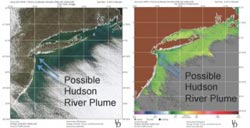Post-Sandy Sewage

University of Delaware<br> <br>True color (left) and sea surface temperature (right) showing slight discoloration and cooler temperatures typical of a river plume from the Hudson River.<br>
“Technically, you can’t identify raw sewage from a satellite, but you can find river discharge that you suspect has raw sewage,” said Matthew Oliver, assistant professor of oceanography in the College of Earth, Ocean, and Environment. “The reason why is because river discharge usually has a very different temperature and color than the surrounding waters.”
Oliver and his students have previously examined the ability of satellites to detect coastal plumes.
Oliver participates in the Mid-Atlantic Regional Association Coastal Ocean Observing System (MARACOOS), which has been carefully following Hurricane Sandy and its after effects. Headquartered at UD, the organization aggregates ocean data collected along the Atlantic coast from Massachusetts to North Carolina to share with researchers, government officials and the public.
As the storm headed up the coast, the New Jersey Department of Environmental Protection (NJDEP) contacted MARACOOS for information. Xiao-Hai Yan, Mary A. S. Lighthipe Professor of Oceanography and director of the Center for Remote Sensing, worked to install the satellite dish at UD to provide real-time coverage of regional disaster events.
“We at UD provide satellite support for MARACOOS,” Yan said. “So that is why we have our images focused on that area right now.”
According to NJDEP, Hurricane Sandy damage took several wastewater treatment facilities offline, causing untreated sewage into certain waterways. Recreational boaters, anglers and crabbers were advised on Friday, Nov. 2, to avoid those waterways and not eat any fish, crustaceans or shellfish from these waters due to contamination from bacteria and viruses. Additional advisories were issued on Nov. 5 and Nov. 6.
Affected waterways are located in northern New Jersey and include the Hudson River, Passaic River, Hackensack River, Newark Bay, Kill Van Kull and Arthur Kill, Raritan Bay, Raritan River, Sandy Hook Bay and northern Barnegat Bay.
Media Contact
More Information:
http://www.udel.eduAll latest news from the category: Ecology, The Environment and Conservation
This complex theme deals primarily with interactions between organisms and the environmental factors that impact them, but to a greater extent between individual inanimate environmental factors.
innovations-report offers informative reports and articles on topics such as climate protection, landscape conservation, ecological systems, wildlife and nature parks and ecosystem efficiency and balance.
Newest articles

Future AR/VR controllers could be the palm of your hand
Carnegie Mellon University’s EgoTouch creates simple interfaces for virtual and augmented reality. The new generation of augmented and virtual reality controllers may not just fit in the palm of your…

‘Game changer’ in lithium extraction
Rice researchers develop novel electrochemical reactor. A team of Rice University researchers led by Lisa Biswal and Haotian Wang has developed an innovative electrochemical reactor to extract lithium from natural…

The blue-green sustainable proteins of seaweed
… may soon be on your plate. The protein in sea lettuce, a type of seaweed, is a promising complement to both meat and other current alternative protein sources. Seaweed…



